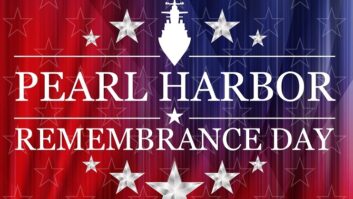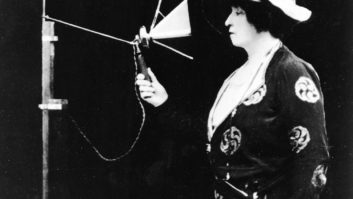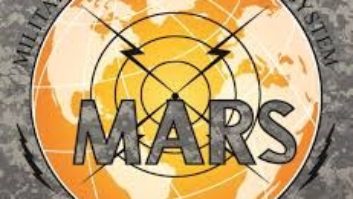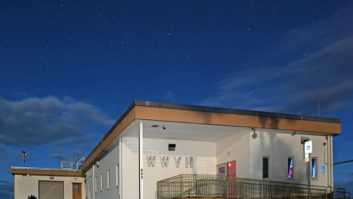
credit: iStockphoto/Ray Roper
The Radio World mailbox was overflowing with responses to Burt Fisher’s letter in the Nov. 21 issue criticizing aspects of the amateur radio scene. Here are some reader takes.
One of the Best Things in My Life
I am responding to a letter posted by Burt Fisher, chief engineer of WCCT(FM), Sandwich, Mass., in which he misses an important aspect of amateur radio, which is the development of many key RF communication technologies by radio amateurs.
A significant number of technical innovations in the RF and digital communications realm were developed by amateur radio operators, either as part of their ham radio hobby activities or as part of their daytime jobs as technologists for universities and corporations.
For example, many of the innovations in vacuum technology over the past 80 years came from the technologists at CPI/Varian/Eimac and RCA, most of whom were amateur radio operators. Much of this technology was initially tested in amateur radio equipment.
As vacuum technology has transitioned to solid-state devices, you will also find that a high percentage of the technologists working on solid-state RF amplifiers are active in ham radio and, once again, much of the practical, early, field testing and perfecting of these devices was carried out with amateur radio equipment.
If you don’t believe me, please check the links posted at radioworld.com/links.
The people who rise to the top of the RF design and manufacturing profession have a passion for “all things RF” and many of them have found a practical, living, laboratory for developing their skills and ideas in the amateur radio operating environment.
Many of my colleagues in broadcast station operations, as well as the broadcast equipment business, are licensed amateur radio operators whose interest in broadcasting can be traced back to amateur radio.
I cannot think of a better “hands on” learning laboratory for young people to learn electronic theory, soldering and equipment construction techniques than building amateur radio equipment.
With the melding of computer and RF technology in modern amateur radio activities and the elimination of the Morse code requirement, more young people are getting involved in amateur radio and the number of licensed amateur radio operators has increased in recent years.
It is still possible to build your own amateur radio equipment, particularly RF power amplifiers, antenna impedance matching networks and antennas.
Modern computer tools like NEC method of moments software make it possible for anyone with basic electronic skills to design and innovate, home-made antennas that can be built from simple wires and other low cost materials.
We now live in the age of computer software, and many amateur radio operators are developing new software-defined modulation waveforms and other applications that can and are being used outside of amateur radio for the benefit of society.
FlexRadio and Elecraft are examples of companies owned by and catering to amateur radio operators that are on the cutting edge of software-defined radio technology (SDR), which is now finding its way in government and consumer communications equipment.
If it had not been for my early involvement in amateur radio, I probably would not have pursued an education in electrical engineering; nor would I have chosen a career track in the broadcast equipment design and manufacturing business.
I spend my workday engaged in the development of state-of-the-art digital RF broadcast equipment.
You would think that is enough RF for one day, but I can’t get enough RF. When I get home from work, I fire up my homebrew linear amplifier, built more than 50 years ago when I was a teenager, with two beautiful 4-400As glowing orange, and work DX stations all over the world with my home-made, computer-designed, wire antennas.
You’ll never convince me that amateur radio is no longer relevant or that it isn’t one of the best things in my life.
Geoffrey N. Mendenhall
Vice President
Transmission Research and Technology
Harris Broadcast Communications
Mason, Ohio
Commentary Was Ham-handed
I would like to reply to Burt Fisher and his rant:
Your comments were rude and certainly misinformed. Consider the number of hams who responded and are still responding to Hurricane Sandy-ravaged communities; or the untold numbers who worked communications during wildfires in Colorado, California and many other states.
Many more volunteer their time and equipment to the American Red Cross, the Salvation Army and countless community emergency operation centers and community events.
What a slap in the face to these public-minded, selfless people.
I belong to three small ham clubs in Northern Connecticut. At a recent meeting of the Bloomfield club, we had in attendance three people who volunteer at a science center, two others are active members of the Civil Air Patrol and three who head up emergency operation centers.
Our president is an EMT who works emergency communications. Most of us are SkyWarn-trained by the National Weather Service, and many worked during Sandy giving valuable information and storm tracking. We also recruit new members and encourage young people to become involved in science and math (and, yes, ham radio). Our ranks are growing.
Another club is part of the Vintage Radio and Communications Museum of Connecticut, which is made up entirely of volunteers who work to preserve our history and offer training and support. We have a huge display of vintage ham and commercial broadcast equipment and a fully functional ham shack open to any licensed ham.
The third group of volunteers work events and handle communications at an emergency operations center in East Granby, Conn.
Some of my ham friends have a fantastic knowledge of radio and electronics, some are superior operators, some are learning, but all are involved in helping the communities in which they live.
So far, Burt, you are the only curmudgeon I have run into.
Maybe you should listen when a major weather event or other disaster strikes; you may change your mind. I’ll paraphrase these lines from the old Bob Dylan song “The Times They Are A-Changin’”: “If you can’t lend a hand, then get out of the way.”
G. Daniel Thomas, KB1WFF
Retired Broadcast Engineer
Weatogue, Conn.
Hams Help When It Counts
Burt Fisher is correct. Most hams cackle endlessly about minutia. After all, it is a recreational hobby.
However, some of them talk from their cars or trucks, which are available to communicate in emergencies when all normal means of communications are down (electricity is off, cell phones are dead, infrastructure is under water).
Also, there is the small percentage of hams who deliberately prepare for disasters, assist authorities and send word to relatives out of the affected area.
Among the 600,000 appliance operators, with the antennas that blight their neighborhoods, there will be some who hear the call for help and can pass the word on to the agencies that can send that needed help.
This is a resource that has shown itself to be valuable in emergencies. If there were no amateur radio, such a resource would not exist.
Jack Althouse, K6NY
Chief Engineer
Palomar Engineers
Escondido, Calif.
Appalling, Mr. Fisher
Burt Fisher claims to be a ham of 52 years but writes about hams that “the vast majority do nothing for public service or little to advance the state of the art. The day of hams being an asset has long disappeared except for some rare instances.”
I, and all of the hams I have talked to, take exception to this “do nothing” label. Ham radio is just a hobby, one that offers a multitude of ways for ordinary people to experience operating their own radio stations.
Whether it be contacting stations across the world and sharing experiences, signal strengths, power and antenna data or operating the new and challenging PSK or digital D-Star modes, there is something for everyone in this hobby.
As such, not every ham need be involved in “public service.” However, a good percentage of hams are ready to help with communications when needed.
When cell towers and land lines failed during Sandy, hams were there to pass along lifesaving messages. Every Sunday night I check in to our local Black Hawk County Amateur Radio Emergency Service net. In emergencies, this group of amateurs provides live-saving communications.
Mr. Fisher is wrong when he says, “Hams are appliance operators who sit in their shacks and cackle endlessly about minutia.”
This branding of the whole ham radio community is appalling. Yes, there are hams who like to talk to other hams, but there are other hams experimenting with ways to better their antennas and the quality of their transmissions. Most of the hams who prefer to just “rag chew” are retirees for which ham radio is a terrific outlet.
Fisher goes on to say that hams “blight the neighborhood” with their antennas and the FCC’s PRB-1 decision protects them. Let’s clarify that.
First of all, amateur radio antennas that do not “blight the neighborhood” can be installed discreetly. Secondly, PRB-1 only comes into play for state and local government regulations, but not for HOA, POA and other covenants signed between house owners and their neighborhood associations.
I cannot figure how a wire antenna such as a dipole or inverted V can “blight” a neighborhood when it cannot even be seen from the street. If one steps back from the antenna, it disappears.
Again, Fisher tarnishes all hams with a wave of his hand. He says the ham test must be easy because his eight-year-old daughter passed it. Perhaps he should recognize that his daughter is pretty smart and should be encouraged, not told that she passed because the test was “easy.”
I don’t mean to speak for all hams. There are many of us in broadcast radio — as evidenced by the always-packed Amateur Radio Operators get-together at the NAB. But I think I speak for the majority of hams when I say that amateur radio is a great hobby with something for everyone.
Many radio engineers have come into the business with experience as a ham operator, and we broadcasters need engineers, so we need to encourage ham radio, not denigrate it.
Doug Vernier, K0DV
President
V-Soft Communications
Cedar Falls, Iowa
Ham Made Me Who I Am
I, too, became a ham just before my 13th birthday. Studying for my license so that I could talk to others over these radios got me interested in radio theory, and even after I got my license, I wanted to learn a little more and more.
About 10 years later, I wound up with a master’s degree in electrical engineering, and am now on the sunset side of a career that has spanned more than 45 years, depending on how you count it.
I’m the interloper in the group; I’m not a broadcast engineer, but I have spent my life developing products for mostly the cable TV industry — more recently fiber optics.
Some products I have worked on have gone on to become reference standards in the industry, so hopefully the industry is a little better because I was here.
And it is directly because of ham radio that I became an engineer.
James O. Farmer, K4BSE
Chief Network Architect
Aurora Networks
Alpharetta, Ga.
Translating Magic of Radio to Younger Generations
I received my novice license at the age of 10 and, as with many others, it was the launching pad for a lifelong learning experience and a great career.
After getting an EE degree and working for several years doing complex communications system design for Motorola, I ended up on the operations side of the cable industry and then in sales and marketing — and eventually became president of a satellite communications equipment manufacturing company serving the cable and broadcast markets.
I can honestly say that many of my multimillion-dollar deals were a direct result of amateur radio being a common bond between my customers and me.
Those bonds remain today and I suspect they will continue as many of us head into retirement.
The challenge for all of us is to translate the magic we experienced in our youth to the techno/sociological world of today’s youth. Amateur radio is such a diverse hobby that I am confident that the younger folks are capable of even more technical contributions once they are exposed to all facets of our hobby.
Ned Mountain, WC4X
Vice President of Business Development,
Strategic Accounts
Pico Digital Inc.
San Diego











